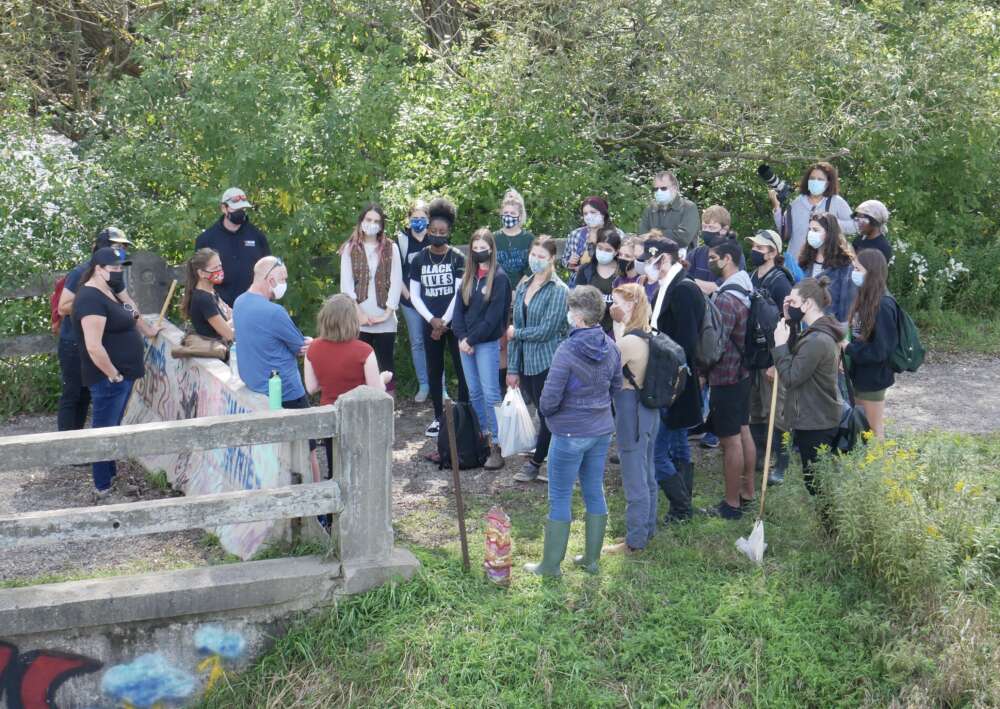
About 20 University of Guelph students, many in the University’s new bachelor of Indigenous environmental science and practice program (BIESP), waded into the Eramosa River this week for a hands-on experience of the life of water.
Sue Chiblow, who will become a professor in the School of Environmental Sciences (SES) as of Nov.1, co-led the “Water Is Life” excursion. An Anishinaabe woman and raised in Garden River First Nation, Chiblow said the students are learning to think about the environment through land-based learning that combines Indigenous and Western science.

“It is the young who stand up and make change,” she said. “This braiding of knowledges will lead to better decisions for a more sustainable environment.”
Leaders of the Chippewas of Nawash Unceded First Nation in Ontario’s Bruce Peninsula first approached the University about developing an environmental and resource management program to train students in ways that would support Indigenous communities.
The program aims to address the need in Canada and elsewhere to improve relationships with Indigenous Peoples and their ancestral and territorial lands, said Chiblow. She said scientists are needed who can work ethically and meaningfully with Indigenous Peoples and within multiple knowledge systems.
Land-based learning is fundamental to the new program, including activities in the first weeks of this inaugural semester of the BIESP. Professors in the program, assisted by Indigenous Elders and Knowledge Holders as well as community organizations and Indigenous practitioners in environmental issues, are guiding outdoor classroom experiences and establishing outdoor learning circles.
They say opportunities exist to share knowledge of plants and animals from Indigenous and Western scientific perspectives.
Chiblow shared the Anishinaabemowin word “bizindam” with students, saying that it means “to listen with your entire being.” It is a foundational concept in Indigenous learning that involves not only the intellect but also the heart and all the senses.

During the excursion, SES professors Dr. Andrew Young and Dr. Paul Sibley led an aquatic entomology component.
Sibley said gauging the health of water involves looking closely at the life within it and the habitat around it. As a start, said Young, “the quickest and easiest thing to do is look at the bugs.”
The excursion also included representatives from Shared Value Solutions, a national company based in Guelph that assists Indigenous communities with regulatory advice, negotiation and business strategy related to major development projects, including mines, hydroelectric facilities and oil and gas pipelines.
BIESP student Sandreka Rowe said the new program is “very cool and very important” because it “involves hands-on learning that you can’t get in the classroom – like walking into a river looking for bugs.”
In high school, Rowe took an environmental science course that helped her discover a passion for understanding and protecting the environment.
“I had never heard of a program like BIESP before,” she said. “It offers the important perspectives we need to change the way we think and fix the environmental problems in the world today.”

Dr. Jesse Popp, OAC Chair of Indigenous Environmental Science, is teaching the Introduction to Indigenous Environmental Science and Practice course in the U of G Arboretum’s Nature Centre and on the land. A learning circle in the arboretum’s Victoria Woods – with logs used as benches – is integral to the experience.
Popp, a member of Wiikwemkoong Unceded Territory, said the green space is an ideal setting for learning about the subject because of its extraordinary forests and diverse flora and fauna.
“It involves stepping outside of the normal classroom and doing a lot of land-based learning,” Popp said. “I once heard an Elder say that you can’t learn Indigenous knowledge without getting dirt under your fingernails.”
Indigenous knowledge systems are rooted in scientific knowledge, she said. Science, whether Indigenous or Western, is the study of the nature and behaviour of natural things and the knowledge obtained about them.

Popp said Indigenous environmental science is science that includes Indigenous knowledge systems and ways of knowing and being – a way of relating to the natural world and to all the human, animal and plant relations within it.
“Indigenous Peoples were the first scientists on Turtle Island, or North America,” she said. “We have this breadth of scientific knowledge that’s been passed down for generations, mostly orally. That doesn’t make it any less valid than Western science.”
For example, she said, Inuit knowledge in the far North is essential to understanding the impacts of climate change, because they have observed its impacts for generations.
Popp said that in Indigenous knowledge systems it is important to “feel with your heart,” be conscious of contributing to reconciliation through science, and always be mindful of having good relations with Earth.
“Slowly, this change, this weaving of Indigenous and Western knowledge systems, is happening,” Popp said. “It is happening everywhere, and it is so exciting, as people recognize how important and equally valuable Indigenous knowledge systems and ways of knowing are.”
For more information on the ways the University is moving towards truth and reconciliation, visit Indigenous Initiatives.
Contact:
Dr. Jesse Popp
poppj@uoguelph.ca
